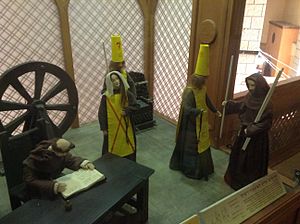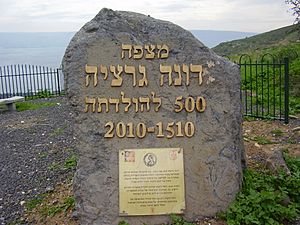Gracia Mendes Nasi facts for kids
Gracia Mendes Nasi (born in 1510, died in 1569) was a very rich and kind Portuguese woman. She was one of the wealthiest Jewish women in Renaissance Europe. People also called her Doña Gracia or La Señora (which means 'The Lady'). She was married to Francisco Mendes.
Gracia was also the aunt and business partner of João Micas, who later became a powerful person in the Ottoman Empire. She created a secret network to help hundreds of Conversos escape from the Inquisition. Her name, Gracia, is Spanish for the Hebrew Hannah, meaning Grace. She was also known by her Christian name, Beatriz (Beatrice) de Luna Miques.
Contents
Early Life in Portugal
Beatriz de Luna was born in Lisbon, Portugal, in 1510. Her family came from Aragon, Spain. They were Jewish people who were forced to become Christian. These people were called Conversos (or Secret Jews).
Her family had moved to Portugal to escape from Spain in 1492. This was when Queen Isabella I of Castile and King Ferdinand II of Aragon forced all Jews to leave Spain. But just five years later, in 1497, all Jews in Portugal were also forced to become Catholic.
Beatriz's father, Álvaro de Luna, was married to Filipa Mendes Benveniste. Filipa was the sister of Francisco and Diogo Mendes.
Marriage and Business in Lisbon
In 1528, Beatriz de Luna married her uncle, Francisco Mendes. He was a very rich trader of black pepper in Lisbon. He was also a "New Christian," meaning he had been forced to convert. Francisco and his brother, Diogo Mendes, ran a very powerful trading company and bank. They had agents all over Europe and around the Mediterranean Sea.
Their company, the House of Mendes/Benveniste, started by trading valuable items. When the Portuguese found a sea route to India, the Mendes brothers became very important spice traders. They also traded in silver, which was needed to buy spices from Asia.
In January 1538, Francisco died when Beatriz was only 28 years old. In his will, Francisco split his wealth between Beatriz and his brother Diogo. This decision helped Beatriz become the successful businesswoman she is known for today. Later, Beatriz even arranged for Francisco's remains to be moved to the Mount of Olives in Jerusalem.
Moving to Antwerp
A few years before Francisco died, his brother Diogo opened a branch of their company in Antwerp, which is now in Belgium. After Francisco's death, Beatriz Mendes moved to Antwerp to join Diogo. She brought her young daughter, Ana, and her younger sister, Brianda de Luna. Moving from Lisbon was a good idea because the political situation in Portugal was changing. In 1536, the Pope Paul III ordered the start of the Portuguese Inquisition, which was dangerous for Jews.
Once in Antwerp, Beatriz invested her family's money in Diogo's business. She started to become known as a successful businesswoman herself. The families became even closer when Beatriz's sister, Brianda, married Diogo Mendes.
But just five years after Beatriz arrived in Antwerp, Diogo also died in 1542. In his will, he left control of the Mendes business empire to Beatriz and her niece. This made Beatriz Mendes an incredibly important businesswoman. Her huge wealth allowed her to influence kings and popes. She used this power to protect other Conversos and to fund her escape network. She also helped publish the Ferrara Bible, a special Jewish book.
Many rulers tried to get her wealth by arranging for her daughter to marry their relatives. If this happened, a lot of the family's money would be lost. Beatriz Mendes fought against all these attempts, even when it put her in danger.
Helping Others Escape
In Antwerp, Beatriz began to create a secret escape network. This network helped hundreds of other Crypto-Jews (secret Jews) flee Spain and Portugal. In these countries, they were always in danger from the Inquisition.
First, these fleeing Conversos were secretly sent on spice ships owned by the House of Mendes/Benveniste. These ships regularly sailed between Lisbon and Antwerp. In Antwerp, Beatriz and her helpers gave them instructions and money. They would travel by cart and on foot over the Alps mountains to the big port city of Venice. From Venice, ships would take them to the Ottoman Empire, which included parts of Greece and Turkey. At that time, the Ottoman Empire, ruled by Muslim Turks, welcomed Jews.
The escape route was planned very carefully. Still, many people died while crossing the high Alps mountains.
Doña Gracia Nasi, through the House of Mendes/Benveniste, dealt with powerful leaders like King Henry II of France, Emperor Charles V, and Sultan Suleiman the Magnificent of the Ottoman Empire. These dealings involved business, loans, and sometimes payments to get things done. Earlier payments to the Pope by the Mendes family had even delayed the start of the Inquisition in Portugal.
Life in Italy
In 1544, Doña Gracia had to move again, this time to the Republic of Venice. She lived on the Grand Canal. Venice offered Jews and Conversos a safe place to live and do business. However, most Jews who openly practiced their faith had to live in crowded ghettos. Because of this, the Mendes family likely practiced Judaism in secret while still appearing Catholic. She continued her successful business, trading pepper, grain, and textiles.
While in Venice, she had a disagreement with her sister, Brianda, about Diogo's money. To avoid a ruling that would split their fortune, Gracia moved again to the nearby city of Ferrara.
The city of Ferrara was happy to welcome the Mendes family. The Duke of Este, Ercole II, Duke of Este, agreed to Diogo Mendes's will so that the rich family would move to his city. He welcomed them in 1549. In Ferrara, for the first time, Beatriz Mendes could openly practice Judaism. She joined a respected Sephardi Jewish community in a city that recognized her rights. This is likely when she started to be known as Doña Gracia Nasi.
Doña Gracia became very involved with the Jewish community in Ferrara. She supported the printing of Jewish books. Because of her kindness and success, books like the Ferrara Bible (published in 1553) were dedicated to her.
Final Years in Constantinople
After settling the dispute with her sister, Doña Gracia, her daughter Ana, and a large group of people moved to Constantinople (now Istanbul) in the Ottoman Empire. This move in 1553 was well-timed, as the political situation in Italy was becoming difficult for Jews. In Constantinople, Doña Gracia lived a fancy life in the European part of the city called Galata. She was very dedicated to her Jewish faith and became a leader in the Sephardi Jewish community of the Ottoman Empire.
After her husband died in 1579, she started her own printing business. She had one press near Constantinople and another in a suburb. She published at least 15 books, including parts of the Talmud and prayer books. She was the first Jewish woman to start her own printing press, and the first woman printer and publisher in the Ottoman Empire.
In 1556, soon after Doña Gracia arrived in Constantinople, Pope Pius V ordered a group of Conversos in Ancona to be burned alive. He claimed they were still practicing Jewish rituals. In response, Doña Gracia organized a trade embargo against the port of Ancona. In Istanbul, she built synagogues (Jewish places of worship) and yeshivas (Jewish schools). One synagogue is named after her, La Señora. These places helped refugees return to their Jewish faith.
In 1558, Sultan Suleiman the Magnificent gave Doña Gracia a long-term lease for the Tiberias region in Galilee. This was part of Ottoman Syria at the time. In return, she promised to greatly increase the yearly tax money from the area. The Sultan had conquered this part of the Holy Land earlier, but it was mostly empty. Doña Gracia gained ruling power over Tiberias. With the Sultan's help, she began to rebuild the abandoned towns there. Her goal was to make Tiberias a major new center for Jewish settlement, trade, and learning. This project is often seen as one of the first attempts at a modern movement to establish a Jewish homeland.
Doña Gracia Mendes Nasi died in Istanbul in early 1569.
Legacy

For a long time, Doña Gracia was not well-known. But since 1969, people have started to remember her, especially women today who see her as an inspiring figure. New York City and Philadelphia have even had "Doña Gracia Day" celebrations. Israel's leaders honored her in 2010. There is now a website and a Facebook page dedicated to her.
The Turkish government has also sponsored events and exhibits about her. Many talks, articles, and festivals have been held in her honor across Europe. Businesswomen and professionals today connect with her ambition, courage, and even her personal struggles.
An Italian white wine has been named after her. The Israeli Government Coins and Medals Corporation has made a special medal. There is now a museum in Tiberias dedicated to her life. She is admired by the descendants of the Conversos she saved, who now live in places like southern Italy, Central and South America, and the United States. In the TV series Muhteşem Yüzyıl, a Turkish actress plays Gracia Mendes Nasi.
See also
 In Spanish: Gracia Nasí para niños
In Spanish: Gracia Nasí para niños
- Esther Handali
- Esperanza Malchi
- Rüstem Pasha
- Nurbanu Sultan
Related books
- Stadtler, Bea. "The story of Dona Gracia Mendes." 1969.
- Birnbaum, Marianna. "The Long Journey of Gracia Mendes." 2001.
- Brooks, Andree "Woman Who Defied Kings: The Life and Times of Dona Gracia Nasi." 2010
- Maynes, Mary Jo., and Ann Beth. Waltner. "Chapter 5 Families in Global Markets." The Family: A World History. Oxford: Oxford UP, 2012. 65–67. Print.



